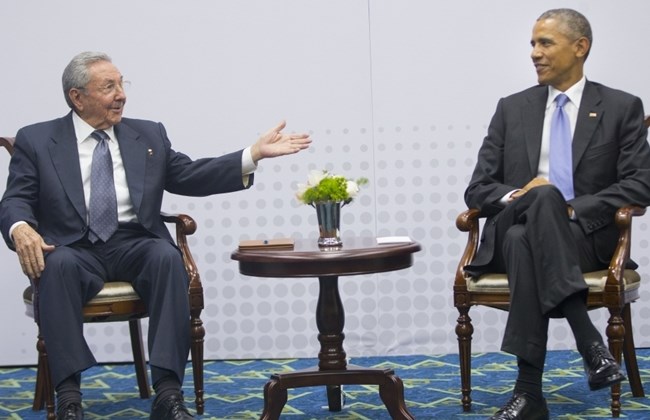
Written by Celso P. Santos exclusively for SouthFront; Edited by Rachel Lane
In Havana, Barack Obama and Raul Castro shook hands and smiled at each other before the cameras on Monday, March 21, before the meeting in the Palace of the Revolution. A Symbolic highlight of the first visit of a American leader to the communist island in decades. The normalization of relations between these two countries was annouced in 2014. The two presidents, who now meet for the third time, will discuss the future of the relationship of the two countries which are marked by profound ideological differences. Before entering the Palace of the Revolution, Obama laid a wreath at the monument to Cuban hero José Martí, located in the palace square. A joint statement is expected after the meeting.
Last week, an editorial published by the official Cuban newspaper Granma, President Castro said he was not willing to “negotiate” a change in the communist policy. In turn, President Obama hopes seize the historic trip to discuss topics sensitive for both countries, such as human rights and individual freedoms on the island.
“We have significant differences on human rights and individual freedoms. But we believe that we can now enhance our ability to promote more change,” Obama said on ABC radio station, Havana. “Changes happen here and I believe that Raúl Castro understands this,” the American leader, recognizing that these differences “will not be night sights for the day.”
The opinion of the American leader on the impact of resuming relations between the two countries and the visit of the US President still divides experts. “I do not believe that President Obama’s visit has an immediate impact on Cuban politics, much less in specific decisions of the regime in the short term,” said Michael Shifter, president of Inter-American Dialogue Center for Analysis.
Memoirs
After almost 90 years, and decades of an adversarial relationship for the first time a US president is on an official visit to Cuba. Barack Obama arrived on the island on Sunday afternoon to mark a further step in its plan of rapprochement with the country. The last US president who traveled to Cuba was officially Calvin Coolidge in a warship, 88 years ago.
Since then, a revolution took place on the island. Cuba aligned itself with the Soviet Union in the socialist bloc during the Cold War. This meant that relations with the United States were completely cut off. From 1961 until today, an economic embargo – among many other restrictions, have been imposed by the American Government putting the two countries on opposite sides.
“They do not conform to the fact that we have made a socialist revolution right under their noses,” said Fidel Castro in a speech that marked the beginning of socialism in Cuba. For many Cubans some things have not changed since that speech.
But with Obama’s visit and the rapprochement with the United States, things must change a little. The idea of the American president is to lift the economic embargo and restore commercial and tourist relations with Cuba. Gradually, he tries to move in that direction – and the visit to the island is a crucial step for this.
Appointment book
On Tuesday the 22, President Obama will deliver a speech to the Cuban people to be broadcast live on state television. Obama will defend freedom of expression, and the right to practice their faith in his long-awaited televised speech on Tuesday in Havana. “I will say that we think the values we believe are universal,” said the leader today. In an interview with US network and ABC News, he said he will keep the same tone used throughout the process. “We come now to maximize our ability to drive further changes, particularly since the visit was well received by Cubans, with huge popularity,” he maintained.
Yesterday, hours before Obama’s arrival, 50 Ladies in White, a female dissident group, and other opponents including the graffiti artist El Sixth, held a demonstration in Havana. The response wasa visible presence of police and supporters of the regime. The group Ladies in White is made up of mothers and wives of political prisoners. They hold peaceful marches to demand respect for human rights on the island.





